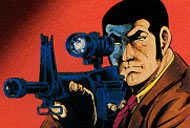
Golgo 13: The Professional
I have always been a fan of James Bond films. I own all but the last two on DVD, and I grew up watching his exploits, amazed at his ability to save the world, get the girl, and be back in London by tea time. There's something about the ruthless yet suave character that has appeal the world over. In many ways, Golgo 13 is a Japanese answer to James Bond. Both series are loaded with beautiful women, expensive cars, gadgets that blow up, and plot twists that would task a Mensa member. Golgo 13 is also similarly popular, at least in his home country, selling millions of copies of the collected manga series over a thirty-year time span. Creator Takao Saito's saga has become one of the greatest hits among salarymen ever.
The difference between the two, however, is also very clear. Golgo 13 follows the exploits of Duke Togo, aka Golgo 13, an assassin for hire. He charges $1,000,000 for a hit on anyone--world leaders, Mafioso bosses, whomever. He has never failed an assignment. He is silent and deadly, hardly ever speaking and never showing a single emotion. Take Bond's brutality, up it by a factor of ten, and then take away the corny jokes and smooth urbane demeanor, and you've got the idea.
Despite this callousness, the manga has always worked very well. Golgo 13 would always have to work through incredible circumstances and strange bizarre twists before coming to the conclusion of any of his missions. Although he doesn't have much of a personality, the plot was always the point. A good enough story always saved the reader from having to consider Duke Togo as a person. Unfortunately, the movie version, Golgo 13:The Professional, doesn't work nearly as well. The film takes the worst parts of the manga, amplifies them, and makes them even more repulsive. As a result, you have a stylish thriller that's often beautifully made, but way too debased for the average person.
As the movie begins, we see Duke take out Robert Dawson, a young man whose father had moments before handed him the keys to his financial kingdom of oil, banking, and business interests. As always, one bullet, one kill. Golgo 13 quickly heads off to his next assignment after stopping for a detached rendezvous with a local prostitute. As he heads from place to place taking out criminals and bedding down hoochie mamas, he realizes that there's a different contingent of folks out for him besides the usual riff-raff. Leonard Dawson, Robert's father, has put all of his resources out on the table to get Golgo 13 disposed of, and he's called in favors from the CIA and the Pentagon to do it. But why isn't he going after the man who ordered the hit on his son's life?
There is one spot in this movie that encapsulates the perfect Golgo 13 adventure. The bad guys know Duke's next hit is on a Nazi officer who's built himself a fortress high-rise. They analyze every possible place that Golgo 13 could take the shot, and they dismiss one because there's no line of sight. But where does he decide to set up shop? Right where they didn't expect, and in a five-minute set piece, they show exactly why Golgo 13 is the best assassin in the business. It's literally just like the manga, and if the whole show had been like that, it would have been great. There are a few places within the movie that you can see that potential.
The artwork itself is also a plus, in that not only is it very uniquely artistic, using different still shots and action bits to its advantage, but it also captures what Golgo 13 should look like. Although some will dismiss it as ugly, it is a spot-on representation of the comic. (There's the issue of a brief computer animated sequence that is just plain awful now in the day of Pentium 4s sitting on every desk, but that's beside the point.)
However, most of the rest of it is just terrible. First, at times, the show is just plain silly. Duke winds up surviving in situations the Terminator might have found a little difficult. He makes it through cars exploding (while he's in them), hails of bullets, and martial arts experts clearly his better while taking out legions of bad dudes with just a pistol. The dialogue is inane, and usually the more risqué it is, the funnier it gets. Then there's the lame-duck soft jazz score that doesn't change regardless of the scene that's good for a laugh. Then there're the henchmen that are rejects right out of Ian Fleming's nightmares.
The rest of the problems aren't funny at all, though. This show has a propensity for both serious misogyny and violent depravity. Although several of the women depicted are career-minded modern feminists, every last one of them winds up as a sexual object. Many of them wind up dead, too, but not before they have a tryst with Duke. The amount of sex and nudity is stunning; though it's not pornographic, there's a lot of it. Considering that Golgo 13 is a complete cold fish, it makes no sense other than to exist for audience titillation. Meanwhile, the violence here is sometimes shocking, but always cold and blunt and nasty. Characters in this show live for violence, and not a one of them has a single redeeming factor. You will not like anyone afterwards.
The Golgo 13 franchise continues to head forward in manga, another anime (reviewed elsewhere on this site), and video games. There's a bit of intrigue to all of this, and the best Golgo products tell interesting stories that don't demean the audience. For all of the good stuff in Golgo 13:The Professional, it's a chilly piece of work that the squeamish should avoid and even the avid fan might find disturbing. I'd start elsewhere if you're really interested in the amoral hitman.
Golgo 13: The Professional -- graphic violence, nudity and sexual situations, rape, profanity -- C-

